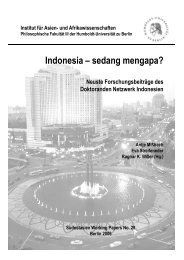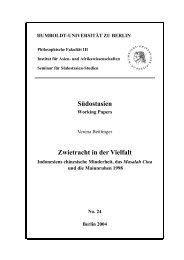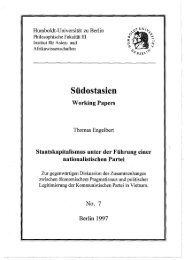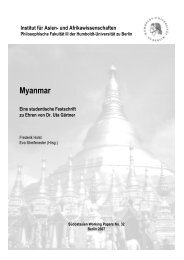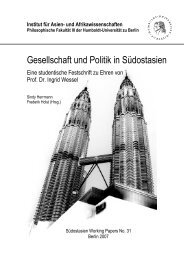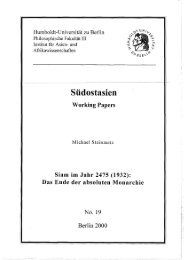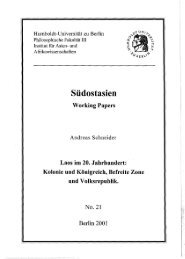On Centrism and Dualism - Humboldt-Universität zu Berlin
On Centrism and Dualism - Humboldt-Universität zu Berlin
On Centrism and Dualism - Humboldt-Universität zu Berlin
Create successful ePaper yourself
Turn your PDF publications into a flip-book with our unique Google optimized e-Paper software.
CENTRISM AND DUALISM<br />
court, hence representing its periphery, may vary from the conception of the high court <strong>and</strong><br />
the attached noble families, representing the center.<br />
In the former case, at the ‘weak’ end of the continuum, the house appears abstract <strong>and</strong><br />
metaphorical <strong>and</strong> is used to articulate social relations. At the ‘strong’ end, the center is often a<br />
stable object, such as a temple, a palace or a set of regalia (ERRINGTON 1989: 239). The<br />
proposed continuum between ‘strong’ <strong>and</strong> ‘weak’ societies, therefore relates not only<br />
different societies, but also links different groups <strong>and</strong> social strata within a single society,<br />
representing different conceptional levels of a single ideology that are hierarchically related.<br />
II.1.2.5. Discussion<br />
My exploration of the house as an analytic concept has shown that it was intended by LÉVI-<br />
STRAUSS to overcome the restrictions of classic anthropological categories, especially those<br />
associated with descent theory, to provide an analytic framework for the systematic study of<br />
cognatic societies. The main reason was, that in these societies organizing principles that were<br />
traditionally conceived to be mutual exclusive <strong>and</strong> that were used to classify societies<br />
according to essentialist ‘types‘, seemed to exist in parallel <strong>and</strong> to be of equal importance.<br />
LÉVI-STRAUSS’ definition (LÉVI-STRAUSS 1982: 174) of the social institution he termed<br />
house, emphasized its corporate character <strong>and</strong> the essentiality of hierarchy as an organizing<br />
principle of house societies. Furthermore, it is the existence of hierarchy that identifies them<br />
as intermediates between elementary <strong>and</strong> complex structures, simultaneously uniting the<br />
commonly opposed principles of descent <strong>and</strong> alliance in a single social system.<br />
Again we find the notion of an intermediate that relates two extremes in a LÉVI-STRAUSSIAN<br />
model. Like the marriage with the patrilateral cross-cousin that relates restricted <strong>and</strong><br />
generalized exchange, the house shares features of elementary <strong>and</strong> complex structures <strong>and</strong><br />
again this sharing is used to indicate a transformation from one to the other <strong>and</strong> to relate both<br />
structurally (cf. WATERSON 1995: 49, 67).<br />
LÉVI-STRAUSS’ concept of house societies was criticized because he presented it as a new<br />
analytic category, a new ‘type’ of society, for which he claimed universal applicability.<br />
According to the general belief in the futility of universal kinship categories (cf. PFEFFER<br />
1992), LÉVI-STRAUSS’ definition has been largely dismissed <strong>and</strong> a major reason for this<br />
dismissal was his reliance on the traditional categories of kinship studies which he originally<br />
intended to overcome. Kinship categories like cognatic <strong>and</strong> unilineal societies <strong>and</strong> their<br />
48



